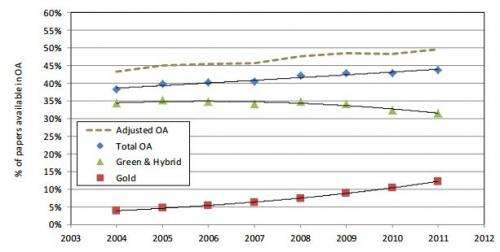Per cent of freely available peer-reviewed papers, 2004-2011. Credit: Science-metrix report
(Phys.org) —Éric Archambault, president of Science-Metrix, is claiming in a paper produced by his company that free access (open-access) to research papers has now reached a "tipping point." The implication is that now that at least as many researchers paper are available for free as those behind paywalls, more and more will be made available for free to the public until eventually all of them can be accessed by anyone that wishes without charge.
The idea of open-access for research papers is a relatively new idea. Online sites such as Nature or Science charge a fee for the right to read the articles they publish. But that, open-access advocates say, hampers scientific progress by preventing a lot of people from using such papers to further their own research. There is also the issue of who really owns the rights to papers produced that cover work paid for by governmental agencies. The Obama administration, tackling the issue head-on, just this past February mandated that all research papers that come about as a result of government funded work be made available free to the public within one year of initial publication. More recently the European Commission has announced that it will implement a similar plan, though the time frame is to be just six months.
To learn more about how many papers are already available for free online, Science-Metrix undertook a study (paid for by the European Commission) using an outside source to estimate the number of papers published in 2008 and subsequently made freely available. That review came back with 32 percent. Not satisfied with that result, the company undertook its own study searching for papers published between 2008 and 2011. They claim to have found free access to 42 percent of 320,000 papers they searched for using netbots. Then, because they estimated that their search engines missed some free articles, they bumped the number up to 50 percent, which led Archambault to make his tipping point claim. The company suggests that the reason the number has grown so high is due to several developments. The first is the growth in open-access sites (from 4 to 12 percent of total published articles over the period 2004-2011). The second and likely making more of impact, however, is the trend towards allowing free access to articles initially published behind paywalls after a certain amount of time has passed—typically a year.
Whether articles published as open-access have indeed reached a tipping point remains to be seen, what is certain now, is that the practice continues to incite great debate in the scientific community regarding both its merits and flaws.
More information: www.science-metrix.com/eng/news_13_08.htm
© 2013 Phys.org





















